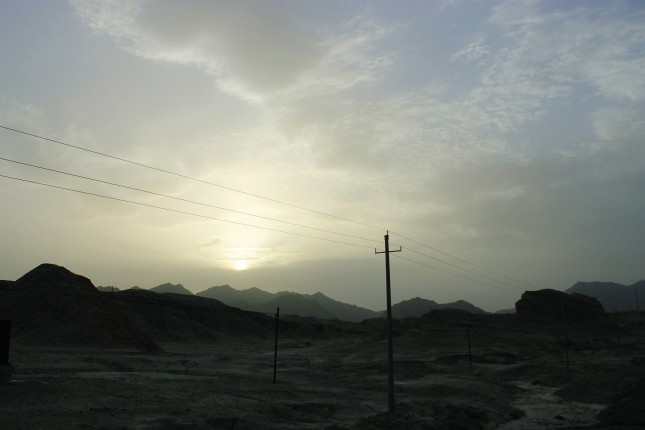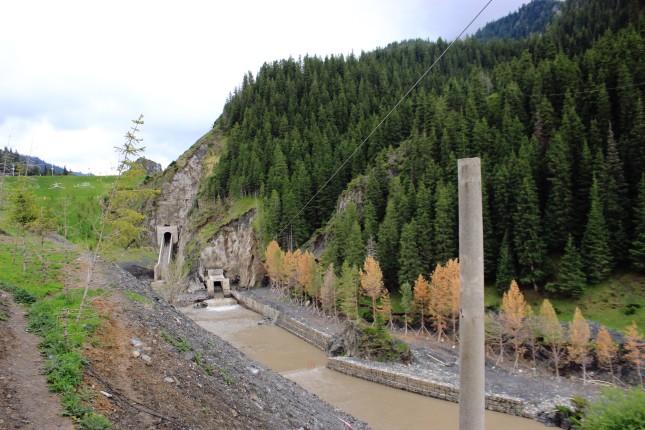-
An Unholy Trinity: Xinjiang’s Unhealthy Relationship With Coal, Water, and the Quest for Development
November 1, 2017 By Meredith Peng
Sitting shotgun in a beat-up vehicle en route to Tashkorgan a small town in the western Chinese province of Xinjiang, I soaked in the magnificence—or what I could see through the dust-coated windshield. The unpaved and rocky road, which carves through the precipitous Karakorum pass, will be (when finished) a key link in China’s “One Belt One Road” plan to connect China to Pakistan. China’s ambitious plans for westward expansion will demand an almost inconceivably enormous amount of energy and resources, and water-scarce Xinjiang will play a central role. With plans like these, how can China meet its water needs?
Sitting shotgun in a beat-up vehicle en route to Tashkorgan a small town in the western Chinese province of Xinjiang, I soaked in the magnificence—or what I could see through the dust-coated windshield. The unpaved and rocky road, which carves through the precipitous Karakorum pass, will be (when finished) a key link in China’s “One Belt One Road” plan to connect China to Pakistan. China’s ambitious plans for westward expansion will demand an almost inconceivably enormous amount of energy and resources, and water-scarce Xinjiang will play a central role. With plans like these, how can China meet its water needs?
I asked the driver what he thought about all this construction. “Of course it is damaging to the environment. But there is nothing we can do about it,” he said. Only government policy could solve the looming problems, but “environmental issues are long-term problems, but the political cycle is short-term.” It takes political will to impose pollution taxes and regulations that could inflict short-term pain for long-term gain (e.g., better public health outcomes, more efficient energy systems). A sense of hopelessness hung in the dust-filled air.

Crisis in the Works
China is facing one of the world’s most acute energy crises. Most of China’s water resources, population, and energy consumption are concentrated in the eastern part of the country, while energy resources are located in the northwest. Northwestern China is extremely water stressed, as water demand, particularly from coal mining and production, far outstrips supply. The impacts of climate change on ecologically fragile Xinjiang and other regions in western China exacerbate the pressures on energy production, which is water intense. Due to rising temperatures, glaciers in the Tianshan Mountains—the main source of water in Xinjiang’s Tarim Basin—are rapidly melting with little chance to replenish. As the country’s increasing energy demand increases its water use, it risks irreversible environmental degradation, which would impact not only China’s western region, but the entire country.
All That Glitters Is Coal
Due to its abundance of coal, and China’s commitment to reducing its use, Xinjiang is also at the forefront of “coal conversion,” a process that converts coal into synthetic natural gas, fertilizers, and other chemicals. While coal plants on China’s eastern seaboard have been shutting down as efforts to meet pollution standards intensify, the number of coal conversion plants have been increasing in water-scarce, resource-rich areas such as Xinjiang. Local governments are able to brand synthetic natural gas created from coal conversion plants as “clean energy” or “new energy” because the process produces relatively lower amounts of particulate emissions.
Many Chinese experts and politicians have voiced concerns about the surge in new coal conversion plants, citing their harmful effects on the environment as well as low return on investment. According to Li Junfeng, the director general of China’s NDRC’s National Center of Climate Change Strategy Research, “it is extremely irrational to develop coal-to-gas technology,” since emissions from coal-to-gas are “270 percent greater than [that of] natural gas from traditional sources.” Greenpeace East Asia reported that the 50 coal-to-gas plants that were slated to be built in China would produce about 1.1 billion tons of carbon dioxide per year—which is equal to one eighth of China’s current total carbon dioxide emissions. In addition, the technology uses 6 to 10 liters of water per cubic meter of synthetic natural gas, equaling around 10 times the amount of water needed for coal production.

Social Instability and Environmental Degradation
Coal conversation and its potential threats to the region have spurred social unrest. In 2014 200 citizens protested the opening of a new coal conversion plant in Oriliq, Xinjiang, citing health and water quality consequences. The environment is culturally significant to the Uyghurs, a marginalized group in Xinjiang. The Uyghurs’ traditional water management structures, such as the ancient karez irrigation systems found in Turfan, use natural processes to store water and irrigate crops. Religious beliefs and cultural traditions in everyday life are associated with karez, including social status, which was accorded based on water ownership rights in the system. According to Shalamu Abudu, a hydrology expert at Texas A&M Agrilife Research Center, “the karez is a symbol of our civilization. It is something we feel very emotional about.”
Turpan’s growing population, as well as the growth of agriculture and the development of oil fields in the area, has increased water demand. New deep wells have met the demand, but reduced the amount in the shallow aquifer, lowering the water table and drying up the karez. Efforts to control flash floods by building dams also damages karez by reducing the recharge of aquifers. By 2003, only 614 of more than 1,784 karez in Xinjiang were still flowing, and their numbers continue to decline. The destruction of the karez system also represents the disappearance and destruction of thousands of years of culture underpinning this marginalized group.
Poor Han Chinese are migrating to the region, drawn by jobs in the growing agricultural and industrial sectors, where they face similar challenges in water quality and adverse health effects from pollution. This is by virtue of both economic status and the particularities of the guanxi system in Xinjiang, which depends on connections, favoring the bingtuan—the original migrants to Xinjiang over the new wave of Han migrants.

A Sustainable Future—or an Insecure One?
Addressing the water-energy nexus the water-energy nexus through innovative approaches to resource management will improve China’s capacity to deal with water shortages. First, China needs better systems for data collection and monitoring. The current systems are insufficient, decentralized, and outdated; much research relies on estimates. The government will need to centralize the water management system, build water quality monitoring stations, and invest in the resources and human capital necessary to manage it. Beijing could use this system to hold local governments accountable for equitable water quotas, and provide performance rewards based on water quality, relative water demand, and robustness of water delivery systems.
The government should move towards creating a sustainable and water-efficient economy in Xinjiang. Steps could include short-term painful job cuts in the agricultural sector, where cotton—a water-intensive crop—is king. It could also mean investing in technologies to optimize energy use and promote cleaner energy, including reducing coal conversion. Investing in clean energy—often at a large, upfront cost—would be a major signal from Beijing that it is taking this nexus seriously. While these steps will be painful in the short term, they are essential to the creation of a more adaptive, sustainable, and equitable society in Xinjiang in the long term.
Finally, more fine-tuned solutions need to be inclusive of all the stakeholders in the region. The government will have to address the concerns of the Uyghurs, the Han migrants, and the bingtuan to maintain social stability—which is essential to meeting the development goals in western China.
Xinjiang figures heavily in the calculus of China’s development strategy as it marches westward. More sustainable development in the region could not only avoid environmental disaster, it could also preserve regional stability.
Meredith Peng is a recent graduate of Georgetown University’s School of Foreign Service. In the summer of 2016, she traveled throughout Xinjiang, China, to conduct fieldwork for her senior honors thesis on water scarcity, pollution, and population pressure. She is currently interning at a technology start-up in Jakarta, Indonesia. Reach her at mp1210@georgetown.edu or check out her travels on her blog, www.thepengyo.com.
Sources: Belfer Center for Science and International Affairs Harvard Kennedy School; China Water Risk; Circle of Blue; Future Directions International; Geografisk Institutt, Norwegian University of Science and Technology; Greenpeace East Asia; Howstuffworks; Middle East Institute; New York Times; Oil and Water: Being Han in Xinjiang by Tom Cliff; Quartz; The Jakarta Globe; The University of Chicago Press Book; World Resources Institute; Yale Environment 360
 A Publication of the Stimson Center.
A Publication of the Stimson Center.






